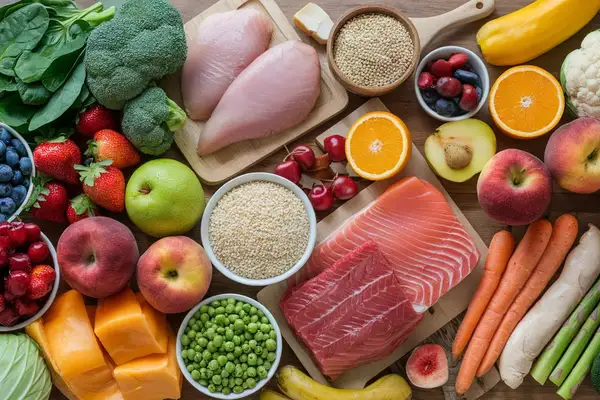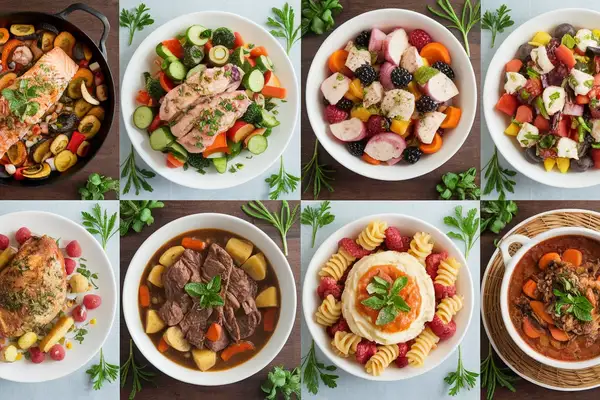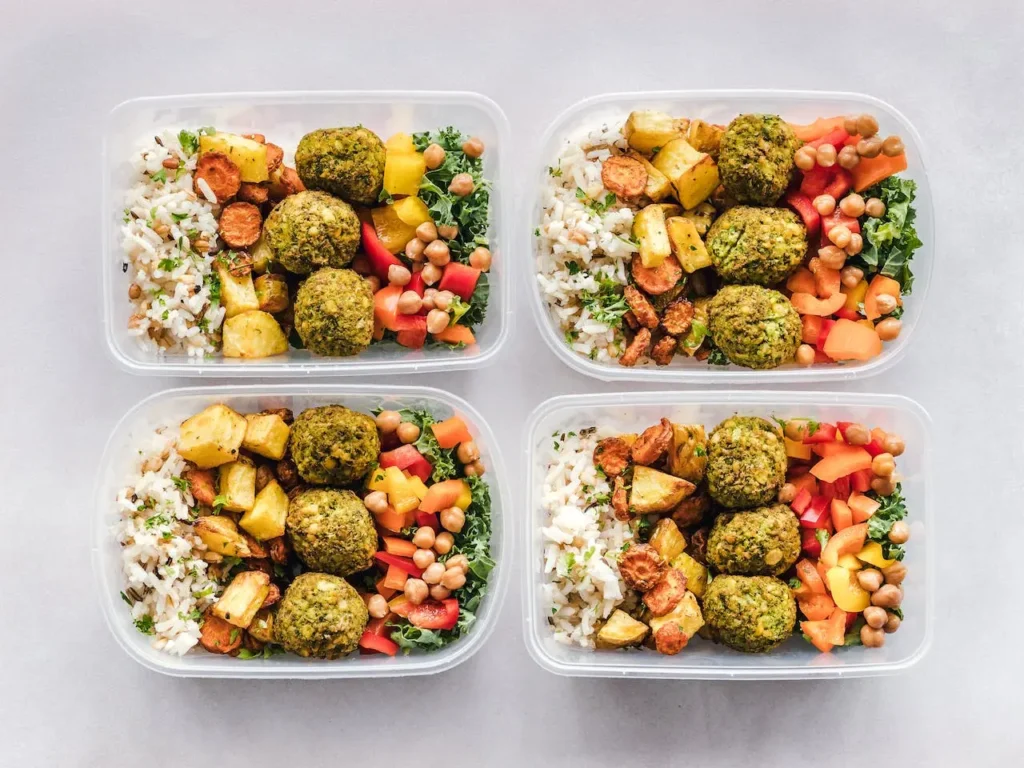7-Day Ozempic Diet Plan with a Detailed Food List
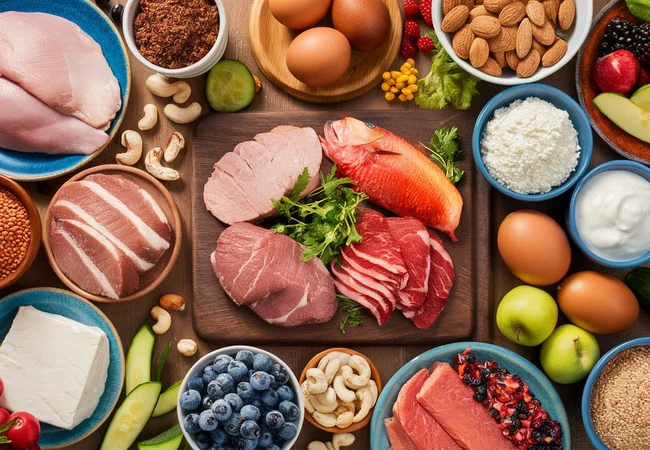
This post may contain affiliate links, meaning I may earn a commission if you make a purchase, at no extra cost to you. I only recommend products I trust. Thank you for your support.
Ozempic, a medication originally designed to manage type 2 diabetes, has garnered significant attention for its weight loss benefits.
As more people discover its potential, the concept of an Ozempic diet plan has emerged.
This comprehensive guide outlines a 7-day Ozempic diet meal plan, including the Ozempic diet menu, foods to avoid, and a list of foods to eat while on Ozempic.
We’ll also provide some delectable Ozempic diet recipes to ensure your weight management journey is effective and enjoyable.
How Does the Ozempic Diet Work?
The Ozempic diet plan focuses on supporting the medication’s appetite-suppressing effects by providing nutrient-dense, satisfying meals.
This approach helps individuals maintain a caloric deficit, essential for weight loss, without feeling deprived.
The Ozempic diet menu emphasizes whole foods, lean proteins, healthy fats, and complex carbohydrates, while minimizing processed foods, sugars, and unhealthy fats.
7-Day Ozempic Diet Plan (Ozempic Diet Menu)
This 7-day Ozempic diet plan includes healthy Ozempic diet recipes and a menu for effective weight management and optimizing the benefits of your medication.
This Ozempic diet meal plan ensures a balance of lean proteins, fruits, vegetables, complex carbohydrates, and healthy fats while avoiding processed and high-sugar foods.

Day 1
Breakfast:
- Spinach & Tomato Egg Scramble: Scramble 2 eggs with 1/2 cup spinach and 1/4 cup diced tomatoes. (2 eggs, 1/2 cup spinach, 1/4 cup tomatoes)
Lunch:
- Broccoli & Cheddar Soup with Chicken: Enjoy 1 cup warm broccoli soup made with low‑fat cheddar and 3 oz shredded chicken. (1 cup soup, 3 oz chicken, 1/4 cup cheddar)
Dinner:
- Baked Salmon with Quinoa Pilaf & Steamed Broccoli and Carrots: Bake salmon; serve with 1/2 cup quinoa pilaf, 1 cup steamed broccoli, and 1/2 cup steamed carrots. (Salmon, 1/2 cup quinoa, 1 cup broccoli, 1/2 cup carrots)
Snacks:
- Almonds & Apple: Snack on 10 almonds paired with 1 small apple. (10 almonds, 1 apple)

Day 2
Breakfast:
- Egg Muffins with Spinach & Mushrooms: Have 2 egg muffins made with 2 eggs, 1/2 cup spinach, and 1/4 cup mushrooms. (2 eggs, 1/2 cup spinach, 1/4 cup mushrooms)
Lunch:
- Steamed Turkey Veggie Medley: Enjoy 3 oz grilled turkey breast with 1 cup steamed broccoli and 1/2 cup cauliflower florets. (3 oz turkey, 1 cup broccoli, 1/2 cup cauliflower)
Dinner:
- Stir-Fried Tofu with Mixed Vegetables & Brown Rice: Stir-fry 4 oz tofu with 1 cup mixed vegetables and serve with 1/2 cup cooked brown rice. (4 oz tofu, 1 cup mixed vegetables, 1/2 cup brown rice)
Snacks:
- Carrot Sticks with Hummus: Enjoy 1 cup carrot sticks with 2 tbsp hummus. (1 cup carrot sticks, 2 tbsp hummus)

Day 3
Breakfast:
- Egg White Frittata: Enjoy a frittata made with 3 egg whites, 1/2 cup diced bell peppers, and 1/4 cup onions. (3 egg whites, 1/2 cup bell peppers, 1/4 cup onions)
Lunch:
- Chicken & Kale Vegetable Soup: Savor 1 cup hearty vegetable soup with 3 oz shredded chicken and chopped kale. (1 cup soup, 3 oz chicken, kale & veggies)
Dinner:
- Grilled Shrimp & Roasted Sweet Potatoes: Grill 6 oz shrimp on skewers and serve with 1/2 cup roasted sweet potatoes. (6 oz shrimp, 1/2 cup sweet potatoes)
Snacks:
- Cottage Cheese with Peaches: Enjoy 1/2 cup cottage cheese with 1/4 cup sliced peaches. (1/2 cup cottage cheese, 1/4 cup peaches)
- Celery with Hummus: Dip 1 cup celery sticks into 2 tbsp hummus. (1 cup celery, 2 tbsp hummus)

Day 4
Breakfast:
- Green Protein Smoothie: Blend 1 cup kale, 1/2 cucumber, 1 scoop protein powder, and 1 cup unsweetened almond milk. (1 cup kale, 1/2 cucumber, 1 scoop protein powder, 1 cup almond milk)
Lunch:
- Hearty Chicken Vegetable Soup: Enjoy a bowl of soup loaded with assorted vegetables and 3 oz shredded chicken. (1 cup soup, 3 oz chicken, mixed vegetables)
Dinner:
- Baked Chicken & Quinoa Pilaf with Steamed Broccoli & Carrots: Bake 4 oz chicken breast seasoned with 1 tsp rosemary; serve with 1/2 cup quinoa pilaf and steamed vegetables (1/2 cup broccoli, 1/2 cup carrots). (4 oz chicken, 1 tsp rosemary, 1/2 cup quinoa, 1/2 cup broccoli, 1/2 cup carrots)
Snacks:
- Bell Pepper Slices with Hard‑Boiled Egg: Enjoy 1 hard‑boiled egg with 1/2 cup sliced bell pepper. (1 egg, 1/2 cup bell pepper)
- Rice Crackers with Guacamole: Enjoy 2 rice crackers with 2 tbsp guacamole. (2 rice crackers, 2 tbsp guacamole)

Day 5
Breakfast:
- Protein Pancakes with Blueberries: Prepare 2 small protein pancakes using 1/2 cup oats, 1 egg, and 1 scoop protein powder; top with 1/2 cup blueberries. (2 pancakes, 1/2 cup oats, 1 egg, 1 scoop protein powder, 1/2 cup blueberries)
Lunch:
- Grilled Vegetable and Tofu Kebabs: Grill 4 oz tofu with 1 cup mixed vegetables on skewers. (4 oz tofu, 1 cup mixed vegetables)
- Turkey Chili Soup: Savor 1 cup low‑carb turkey chili with assorted beans and vegetables. (1 cup soup, 3 oz ground turkey, beans, veggies)
Dinner:
- Herb‑Roasted Chicken Breast with Green Beans & Sweet Potato Mash: Bake 4 oz chicken breast with 1 tsp mixed herbs; serve with 1 cup steamed green beans and 1/2 cup sweet potato mash. (4 oz chicken, 1 tsp herbs, 1 cup green beans, 1/2 cup sweet potato mash)
Snacks:
- Greek Yogurt with Walnuts & Cinnamon: Enjoy a 5‑oz serving of Greek yogurt mixed with 5 walnuts and a pinch of cinnamon. (5 oz Greek yogurt, 5 walnuts, cinnamon)

Day 6
Breakfast:
- Chia Seed Pudding: Prepare chia pudding overnight with 1 cup unsweetened almond milk and 1/2 cup raspberries. (1 cup almond milk, 1/2 cup raspberries, chia seeds)
Lunch:
- Turkey and Avocado Wrap: Wrap 3 oz turkey and 1/4 avocado in 1 whole grain tortilla. (3 oz turkey, 1/4 avocado, 1 tortilla)
Dinner:
- Baked Trout with Broccoli & Brown Rice: Bake 4 oz trout with a lemon wedge; serve with 1 cup steamed broccoli and 1/2 cup brown rice. (4 oz trout, 1 lemon wedge, 1 cup broccoli, 1/2 cup brown rice)
Snacks:
- Cucumber Slices with Hummus: Dip 1 cup sliced cucumbers in 2 tbsp hummus. (1 cup cucumber, 2 tbsp hummus)
- Low-Fat Cottage Cheese with Pineapple Chunks: Mix 1/2 cup cottage cheese with 1/4 cup pineapple chunks. (1/2 cup cottage cheese, 1/4 cup pineapple)
- Carrot Sticks & Tzatziki: Enjoy 1 cup carrot sticks with 2 tbsp tzatziki. (1 cup carrots, 2 tbsp tzatziki)
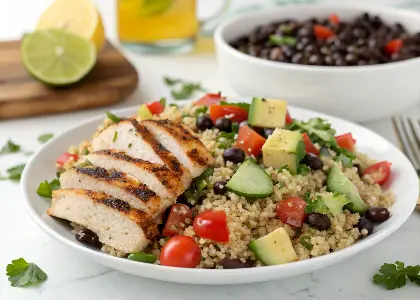
Day 7
Breakfast:
- Veggie Omelet: Enjoy an omelet made with 2 eggs, 1/2 cup spinach, 1/4 cup mushrooms, and 1/4 cup onions. (2 eggs, 1/2 cup spinach, 1/4 cup mushrooms, 1/4 cup onions)
Lunch:
- Quinoa and Black Bean Salad: Toss 1/2 cup quinoa, 1/2 cup black beans, 1/4 cup diced tomatoes, and 1/4 cup corn together. (1/2 cup quinoa, 1/2 cup black beans, 1/4 cup diced tomatoes, 1/4 cup corn)
- Grilled Chicken Breast: Grill 3 oz chicken breast. (3 oz chicken)
Dinner:
- Tuna Salad over Arugula: Mix 3 oz tuna with 2 cups fresh arugula, dressed with 1 tbsp olive oil and lemon juice. (3 oz tuna, 2 cups arugula, 1 tbsp olive oil & lemon juice)
- Roasted Tomato & Basil Soup with Turkey Croutons: Savor 1 cup of roasted tomato basil soup enriched with 3 oz diced turkey pieces. (1 cup soup, 3 oz turkey, fresh basil)
Snacks:
- Mixed Berry Medley & Cottage Cheese: Enjoy 1/2 cup mixed berries with 1/2 cup low‑fat cottage cheese. (1/2 cup berries, 1/2 cup cottage cheese)
- Rice Cakes with Almond Butter: Top 2 rice cakes with 1 tbsp almond butter. (2 rice cakes, 1 tbsp almond butter)
Foods to Eat While on Ozempic
When following the Ozempic diet, it’s crucial to focus on a balanced and healthy eating plan that includes specific food groups to minimize side effects and support your weight loss journey.
Here’s a detailed list of foods to eat while on Ozempic:
Lean Proteins
- Skinless chicken breast
- Skinless turkey
- Lentils and legumes
- Lean beef
- Bison
- Plain cottage cheese
- Fish (Salmon, tuna, cod, tilapia, shrimp)
- Lean cuts of pork
- Eggs
- Greek yogurt
- Tofu
- Tempeh
Leafy Greens and Low Starchy Vegetables
- Spinach
- Lettuce (Romaine, Iceberg, Butterhead)
- Swiss Chard
- Carrots
- Broccoli (in small amounts)
- Kale
- Cauliflower (in small amounts)
- Beets
- Sweet potatoes (in small amounts)
- Turnips
- Cucumbers
- Zucchini
- Squash (Butternut, Acorn, Spaghetti)
- Pumpkin
- Corn (in small amounts)
- Mushrooms
- Okra
- Artichokes
- Radishes
Nuts and Seeds
- Almonds
- Cashews
- Brazil nuts
- Pecans (in small amounts)
- Walnuts
- Pistachios
- Pine nuts
- Macadamia nuts (in small amounts)
- Hazel nuts
Legumes
- Chickpeas (Garbanzo beans)
- Lentils
- Black beans
- Kidney beans
- Green peas
- Edamame
Whole Grains
- Quinoa
- Brown rice
- Whole wheat pasta
- Oats
- Barley
- Farro
Healthy Fats
- Avocados
- Olive oil
- Fatty fish (Salmon, Mackerel, Sardines)
- Nut butters (Almond Butter, Peanut Butter)
Fruits
- Berries (Strawberries, Blueberries, Raspberries)
- Apples
- Bananas
- Citrus fruits (Oranges, Grapefruits, Lemons)
- Pears
- Grapes
- Melons
- Plums
- Pomegranates
- Dates
- Apricots
- Pineapples
Low-Fat Dairy
- Greek yogurt
- Skim milk or 1% milk
- Cottage cheese
- Low-fat cheese (Mozzarella, Cheddar)
- Low-fat kefir
- Low-fat cream cheese
Foods with High Water Content
- Soup
- Clear, ice-cold beverages
Ozempic Foods to Avoid
When on the Ozempic diet, it’s crucial to be mindful of the foods you consume to manage potential side effects such as nausea and stomach discomfort.
Here’s a detailed list of foods to avoid while on the Ozempic diet:
Fatty Foods
- Fried foods (e.g., french fries, fried chicken, onion rings)
- Processed meats (e.g., bacon, sausages, hot dogs)
- Fast foods (e.g., burgers, pizza, nachos)
- Full-fat dairy (e.g., full-fat cheese, whole milk, cream)
- Baked goods (e.g., croissants, pies, buttery pastries)
- Nut butter (e.g., peanut butter, almond butter, if consumed excessively).
High-Sugar Foods
- Cakes and pastries (e.g., chocolate cake, cupcakes, muffins, donuts)
- Candies and confections (e.g., gummy bears, hard candies, chocolates, fudge)
- Cookies and biscuits (e.g., chocolate chip cookies, shortbread, gingerbread)
- Ice Cream and frozen desserts (e.g., sorbet, frozen yogurt)
- Pies and tarts (e.g., apple pie, lemon tart, pecan pie)
- Sweetened breakfast cereals (e.g., sugar-coated cereals, granola with added sugar)
- Dessert sauces (e.g., caramel sauce, chocolate syrup, fruit compotes)
Highly Processed Foods
- Processed meats (e.g., hot dogs, deli meats)
- Packaged snacks (e.g., chips, crackers)
- Frozen meals
- Instant noodles
High-Carbohydrate Foods
- White bread
- Pasta
- White rice and sticky rice
- Sugary cereals (e.g., granola)
- Baked goods made with refined flour (e.g., cakes, cookies, pastries)
Cruciferous Vegetables
- Cabbage
- Brussels sprouts
- Asparagus
Sweet Foods and Drinks
- Sodas and soft drinks (e.g., regular cola, lemon-lime soda, root beer)
- Fruit juices (e.g., orange juice, apple juice, grape juice with added sugars)
- Sweetened tea (e.g., iced tea with added sugar, bubble tea)
- Flavored milk (e.g., chocolate milk, strawberry milk)
- Energy drinks: (e.g., red bull, monster, other sugary energy drinks)
- Smoothies (commercial smoothies with added sugars)
- Milkshakes (e.g., chocolate milkshakes, vanilla milkshakes, fruit milkshakes)
Alcohol and Caffeine
- Beer
- Wine
- Spirits
- Cocktails
- Liqueurs
- Coffee
Strong-Smelling Foods
These can cause vomiting for some individuals on Ozempic.
- Garlic (e.g., fresh garlic, garlic powder, garlic-infused oils)
- Onions (e.g., raw onions, sautéed onions, onion powder)
- Cheese (e.g., blue cheese, roquefort, limburger)
- Cabbage (e.g., cooked cabbage, sauerkraut, kimchi)
- Brussels sprouts
- Spices (e.g., cumin, curry powder, asafoetida)
Benefits of the Ozempic Diet
The Ozempic diet, when combined with the use of the medication Ozempic (semaglutide), is associated with several potential benefits for individuals with type 2 diabetes and those seeking weight management.
Here are the detailed benefits of the Ozempic diet:
1. Blood Sugar Control:
- Helps regulate blood sugar levels by reducing the production of glucose by the liver and increasing insulin secretion.
2. Weight Loss:
- Aids in weight management due to its appetite-suppressing effects, leading to reduced calorie intake and potential fat loss.
3. Cardiovascular Benefits:
- Studies have shown that Ozempic may reduce the risk of heart attack, stroke, and cardiovascular death in individuals with type 2 diabetes and established cardiovascular disease.
4. Improved Glycemic Control:
- Enhances glycemic control, leading to reduced HbA1c levels and improved overall blood glucose management.
6. Appetite Suppression:
- Helps in reducing appetite, leading to a decreased desire for high-calorie and high-carbohydrate foods.
7. Lowered Risk of Hypoglycemia:
- Provides a lower risk of hypoglycemia compared to some other diabetes medications.
8. Potential Positive Impact on Metabolism:
- May have a positive impact on metabolism, leading to improved energy levels and metabolic rate.
Conclusion
In conclusion, the Ozempic diet offers a promising approach to achieving weight management goals for individuals with type 2 diabetes and those seeking quick weight loss.
By emphasizing healthy eating habits, appetite control, and improved blood sugar regulation, the Ozempic diet provides a comprehensive strategy for weight management and overall health improvement.
However, it’s important to note that the Ozempic diet should be approached in consultation with a healthcare professional to ensure its suitability for individual health conditions and needs.
Overall, the Ozempic diet presents a valuable tool in the pursuit of weight management goals.
- No carb diet plan
- GLP-1 meal plan Zepbound
- Blue Zone diet for beginners
- 7-day animal-based diet
- 7-day vegetarian meal plan
- Vegan meal plan with a grocery list
- Is the paleo diet healthy?
- 7-day plant paradox diet plan
- Benefits of pineapple for men
- Foods to avoid while on Saxenda
- Carnivore diet meal plan
- 7-day GERD diet plan
- Diabetic meal plan
- 7-day meal plan for gestational diabetes
FAQs
What is the Ozempic diet?
The Ozempic diet is a nutrition plan designed to complement the use of Ozempic (semaglutide), a medication for managing type 2 diabetes and aiding weight loss.
The Ozempic diet emphasizes whole foods, lean proteins, healthy fats, and fiber-rich carbohydrates while avoiding high-sugar, high-fat, and high-carbohydrate foods.
Can I eat eggs on Ozempic?
Yes, you can eat eggs while taking Ozempic. Eggs are an excellent source of lean protein and essential nutrients, making them a healthy option for breakfast or any meal.
How many calories should I eat on Ozempic?
The number of calories you should consume while on Ozempic depends on individual factors like age, gender, weight, activity level, and health goals. A typical range might be 1,200 to 1,800 calories per day for weight loss.
Can I eat bananas on Ozempic?
Yes, you can eat bananas while taking Ozempic. Bananas are a healthy fruit that provides essential nutrients like potassium, vitamin C, and fiber. However, they should be consumed in moderation due to their higher carbohydrate content.
What diet should I follow while on Ozempic?
While on Ozempic, it’s recommended to follow a balanced diet that includes lean proteins, whole grains, healthy fats, non-starchy vegetables, and low-glycemic fruits.
Avoid high-sugar, high-fat, and high-carbohydrate foods to maximize the medication’s effectiveness and support weight management.
Can I eat oatmeal while on Ozempic?
Yes, you can eat oatmeal while taking Ozempic. Oatmeal is a nutritious whole grain that provides fiber, which can help with satiety and blood sugar control. Choose plain, unsweetened oatmeal and add healthy toppings like fruits, nuts, or seeds.
What is the best protein to eat on Ozempic?
The best proteins to eat while on Ozempic include lean sources like chicken breast, turkey, fish (such as salmon and cod), tofu, legumes, and low-fat dairy products. These proteins support muscle maintenance and help you feel full longer.
What happens if you eat junk food while taking Ozempic?
Eating junk food while taking Ozempic can counteract the medication’s benefits, leading to poor blood sugar control and hindering weight loss efforts.
Junk food is typically high in sugar, unhealthy fats, and calories, which can diminish the effectiveness of Ozempic.
Resources
- Healthy Eating for Type 2 Diabetes
- What Is a Type 2 Diabetes-Friendly Diet?
- Diabetes and Low-Carb Recipes
Disclaimer: The information provided in this Ozempic diet plan is for educational purposes only and is not intended as medical advice. Always consult with a healthcare professional before starting any new diet.
